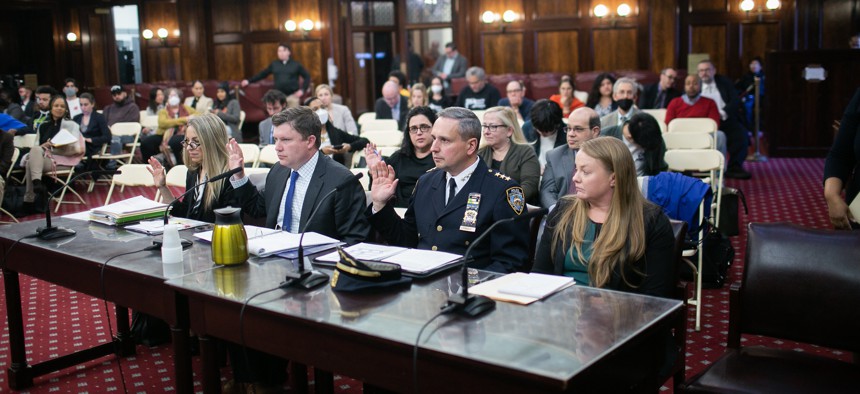Policy
City Council bills would require NYPD to document every street stop
The NYPD says documenting the stops would be ‘onerous’ and take too long.

NYPD Director of Legislative Affairs Michael Clarke (second from left) testifies at a City Council hearing on March 27, 2023. William Alatriste/New York City Council Media Unit
The New York City Police Department could soon be required to report on all low-level police street stops and interactions with civilians, thanks to a pair of proposed City Council bills aimed at bolstering the department’s transparency. Advocates say the measure is necessary to show the true toll of police interactions on Black and brown New Yorkers. Currently, the police department is only required to document formal stops (which are known as Level 3 encounters) but not the far more frequent lower-level encounters.
The police department has objected to the bills. During a Council hearing on Monday, a high-ranking NYPD official argued that requiring officers to record the details of every low-level encounter would be “onerous” and take up so much time that officers might be delayed from solving crimes or looking for missing children.
“How about a case with a missing five-year-old child, which may be the most time sensitive investigation one can imagine? Dozens or hundreds of officers are dispatched and dozens or hundreds of everyday New Yorkers are asked if they’ve seen the missing child,” said Michael Clarke, the NYPD’s director of legislative affairs. “To ensure the accuracy of reports, officers would need to stop and take down each witness’ demographic information. This will invariably slow down the investigation and as such hinder an officer from obtaining valuable information.”
During the hearing, Clarke said that the NYPD “does not fear transparency” but simply considers lower-level encounters to be so routine that it would be prohibitively difficult to log all of them.
He described Level 1 encounters as the “most basic interactions” between police officers and members of the public: speaking to witnesses while responding to a 911 call, assisting sick passengers on the subway, asking New Yorkers if they’ve seen a missing child. Level 2 interactions occur when an officer stops someone suspected of criminal activity. In both cases, Clarke said, the interaction is strictly voluntary and the individual is free to walk away if they want – unlike in a Level 3 encounter.
Although the NYPD sought to portray Level 1 and Level 2 encounters as being little more than voluntary chats between officers and citizens, City Council Speaker Adrienne Adams and Public Advocate Jumaane Williams said that New Yorkers often do not feel free to leave encounters with armed police officers – and sometimes, are not even allowed to leave by the police.
“Despite being lower-level stops, the feeling of being stopped, questioned, and possibly searched by police is indistinguishable from the experience of Level 3 stops,” Williams said.
The two Council bills – Intros 538 and 586, which have been dubbed the “How Many Stops Act” – were largely designed to get a better idea of how the NYPD interacts with community members. While the NYPD is currently required to document Level 3 stops – when police have the authority to detain someone and prevent them from leaving – the department does not release any information related to lower-level interactions between police officers and the public. The NYPD’s own data has revealed well-documented racial disparities when it comes to formal “stop-and-frisk” stops (which are considered Level 3), but there currently isn’t a clear, data-backed picture about which populations are most impacted by lower-level stops.
Intro 586 would require the NYPD to report information about all interactions between the police and the public – whether Level 3, 2 or 1. This would include the ethnicity, age, and gender of the person who police approached as well as the reason, location, and whether any force or enforcement action was taken. Intro 538 would require the NYPD to detail its use of searches when a person does or doesn’t consent. According to Williams, the bills would build on the Right to Know Act which was passed in 2017.
“There is a clear racial difference in who is being stopped and who’s not and who has been policing those guys. Often the answer (police give) is because of the violence that is occuring there,” Williams said. “I heard that 10 years ago, I heard it in the ‘90s when I was growing up, I heard it in the ‘80s before that and people heard it for decades which means at some point what we are doing isn’t effective because it’s not changing the way that the violence is occuring … My hope is that at some point we can have a discussion about what public safety actually is, what (the) police’s role is in that.”
In addition to the How Many Stops Act, Council members considered a slate of other measures aimed at increasing the NYPD’s transparency and the degree to which the department can be held accountable to the public – including several measures related to access to body camera footage and legislation that would require the NYPD to produce an annual report listing anyone who donated more than $1 million to the department in a single year and how that money was used.
Monday’s hearing, held by the public safety committee, comes at a particularly tense time between the City Council and NYPD. Last week, Council members pressed the department last week about its soaring overtime spending. Before that, the Council had to postpone multiple hearings about the NYPD’s Strategic Response Group – which is known for violently breaking up protests – after the department repeatedly refused to send any representatives to testify about the controversial unit.

